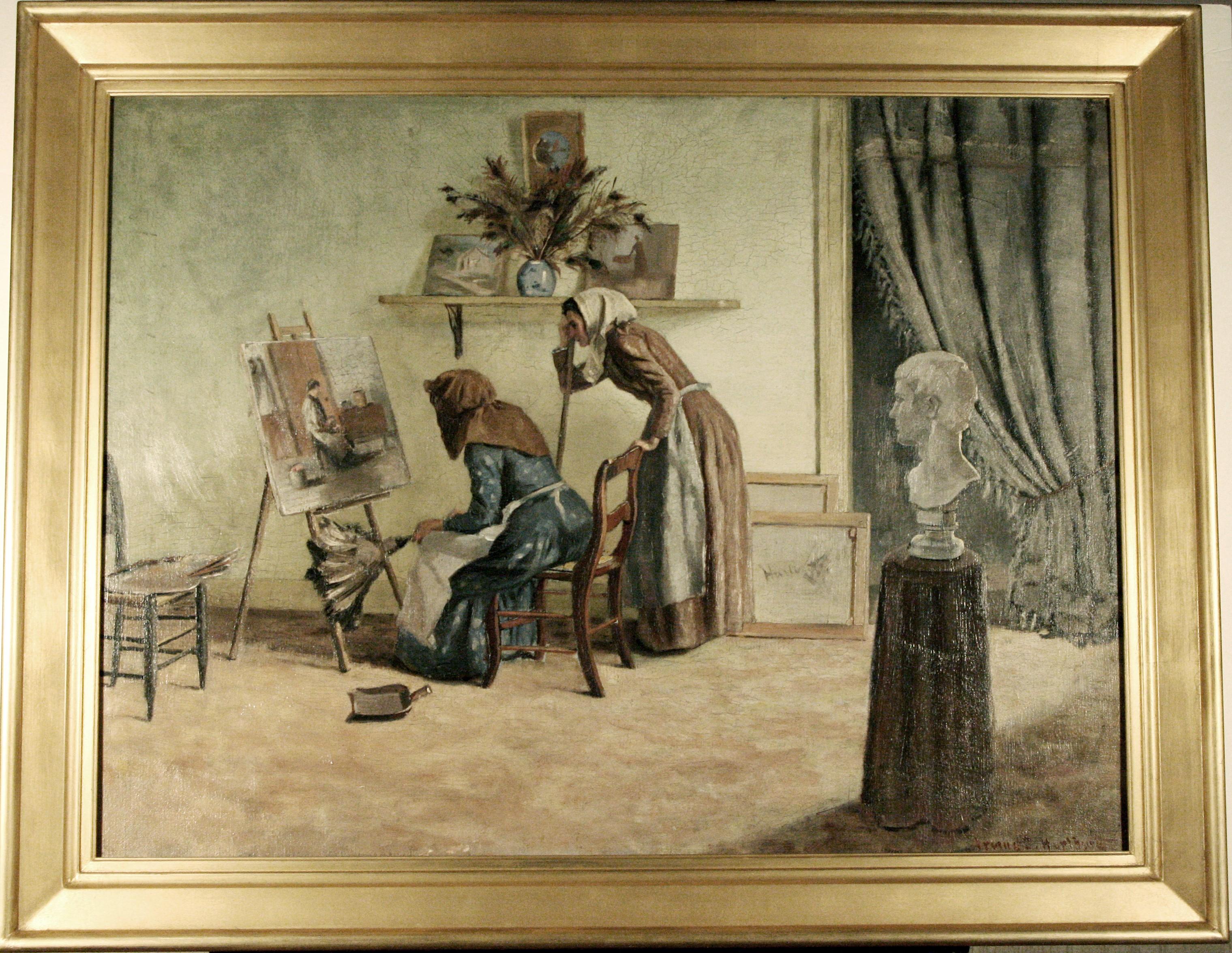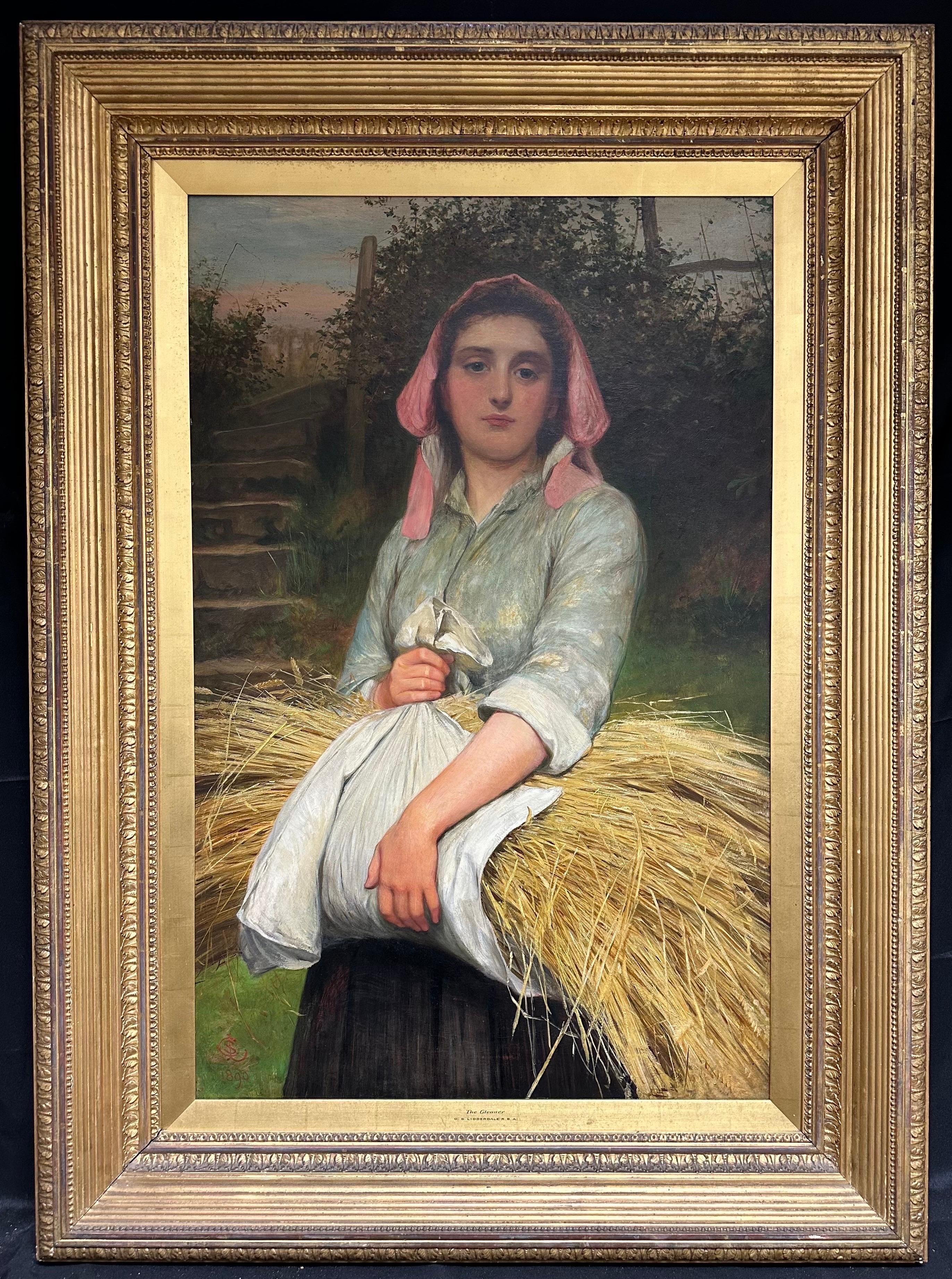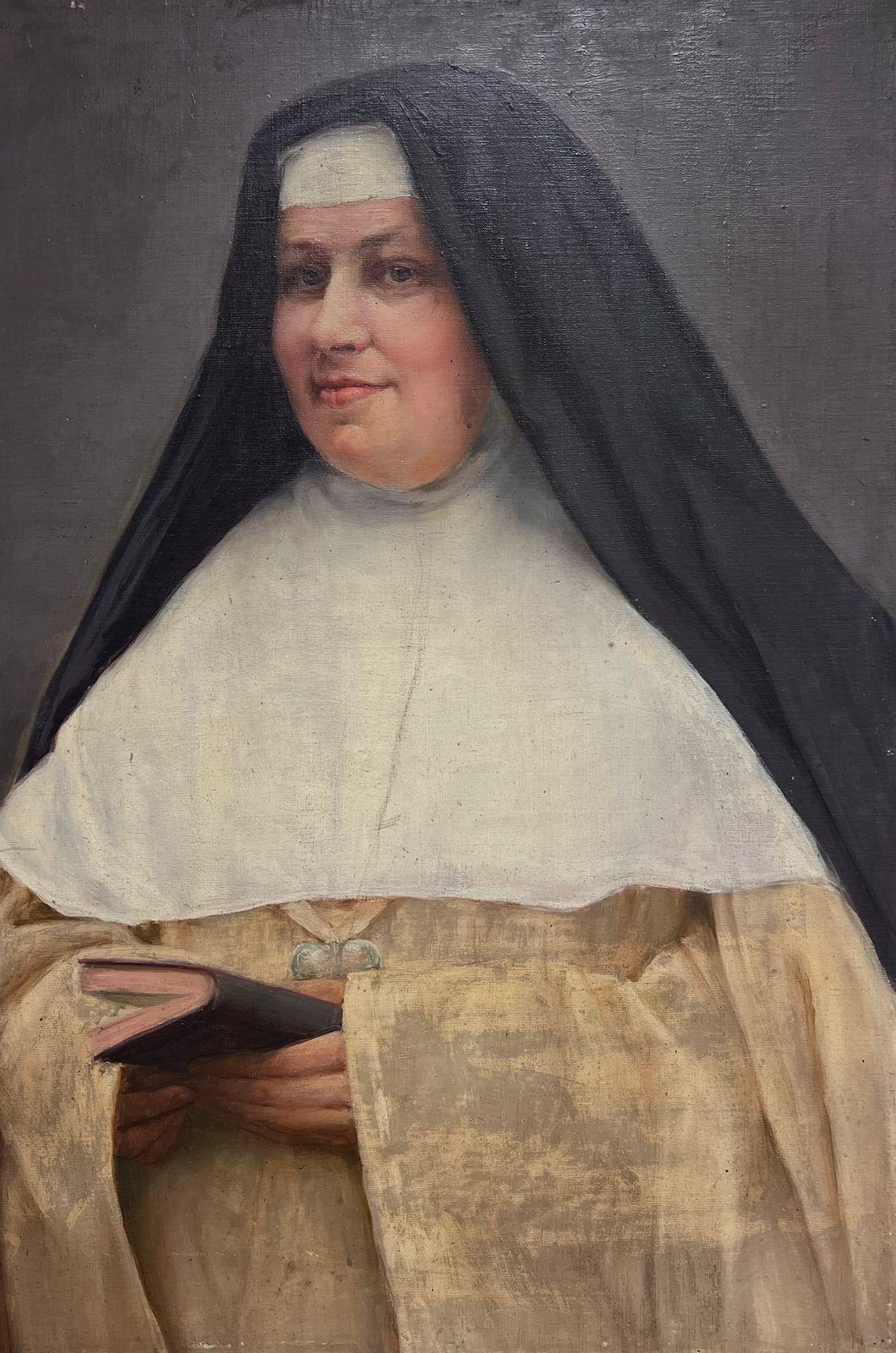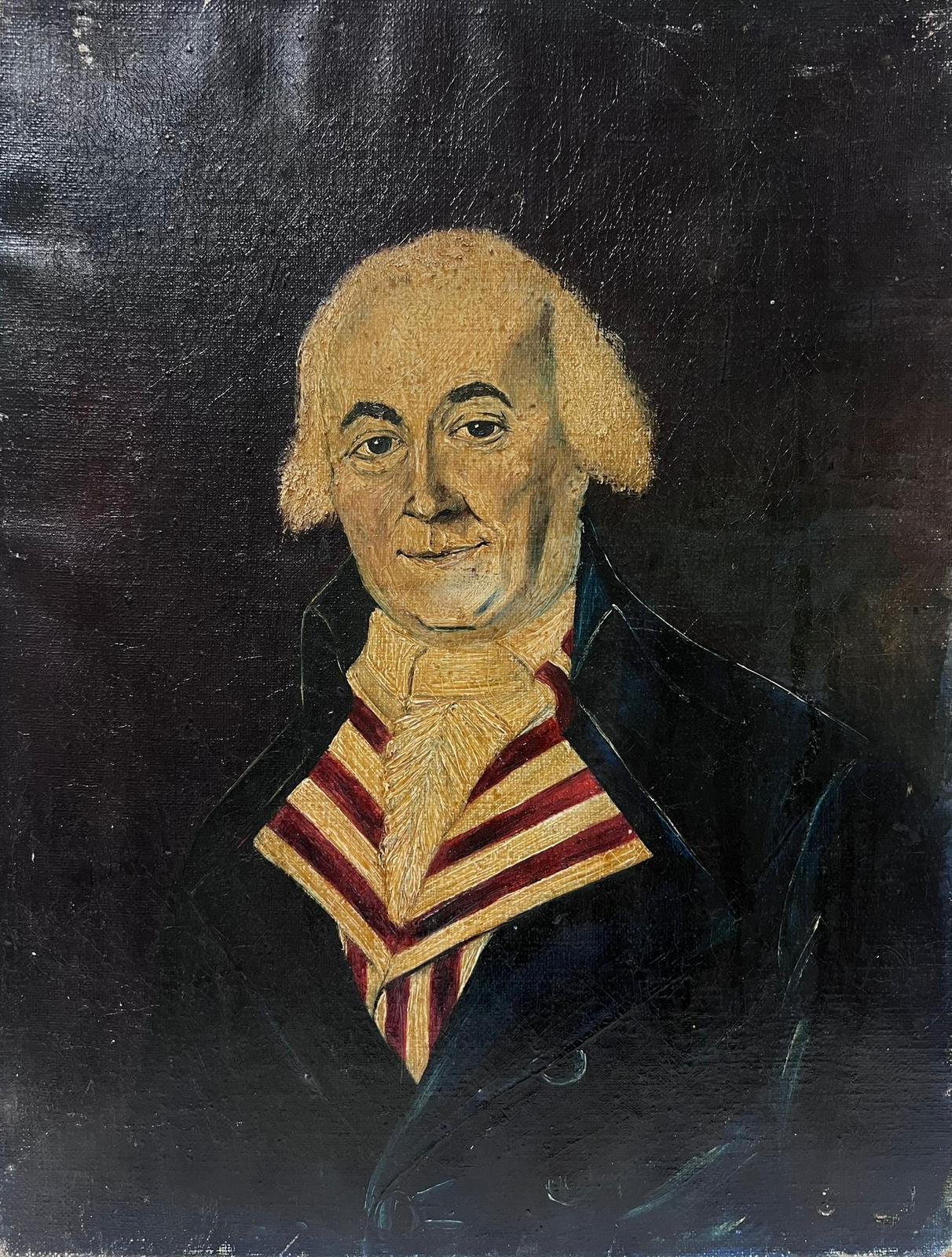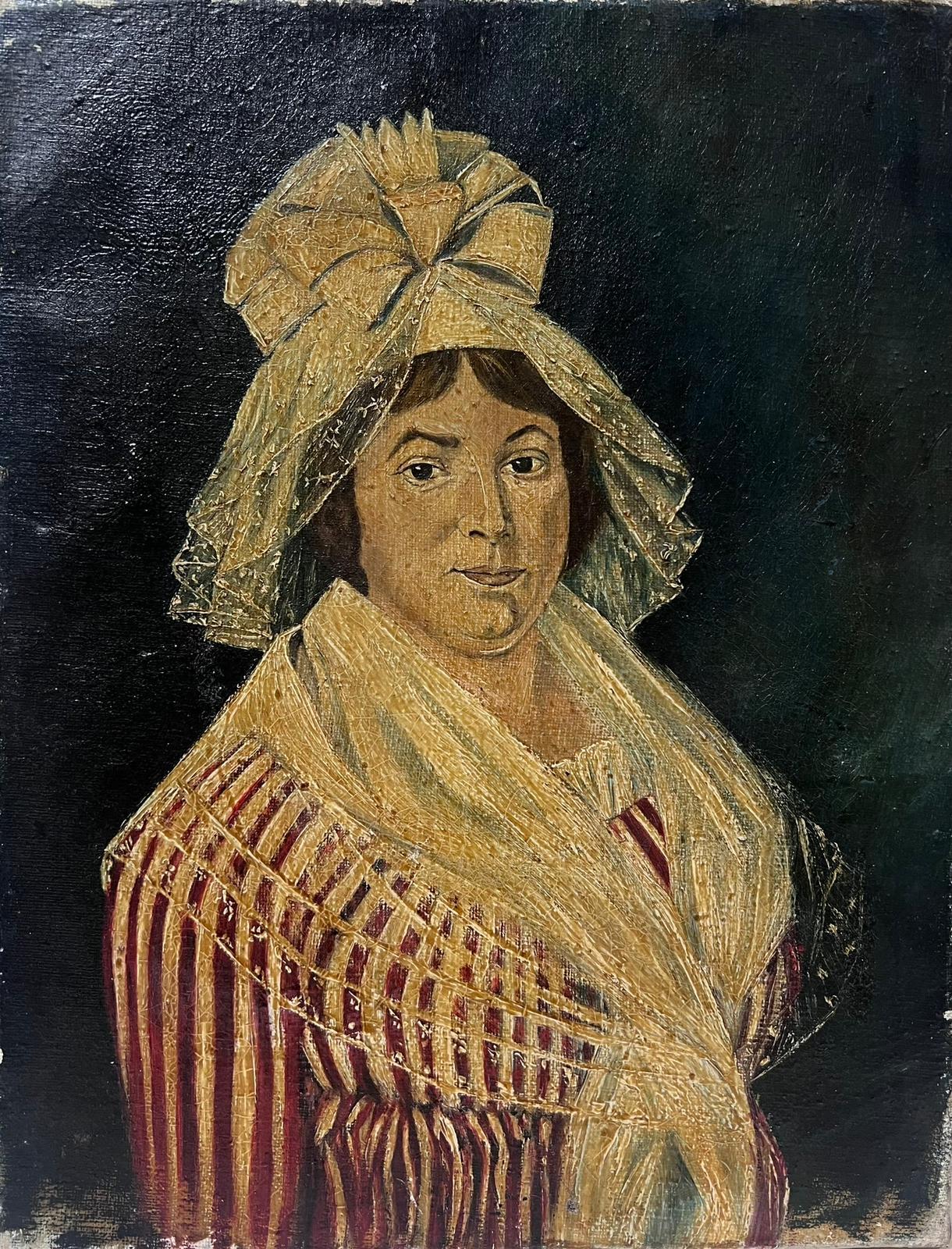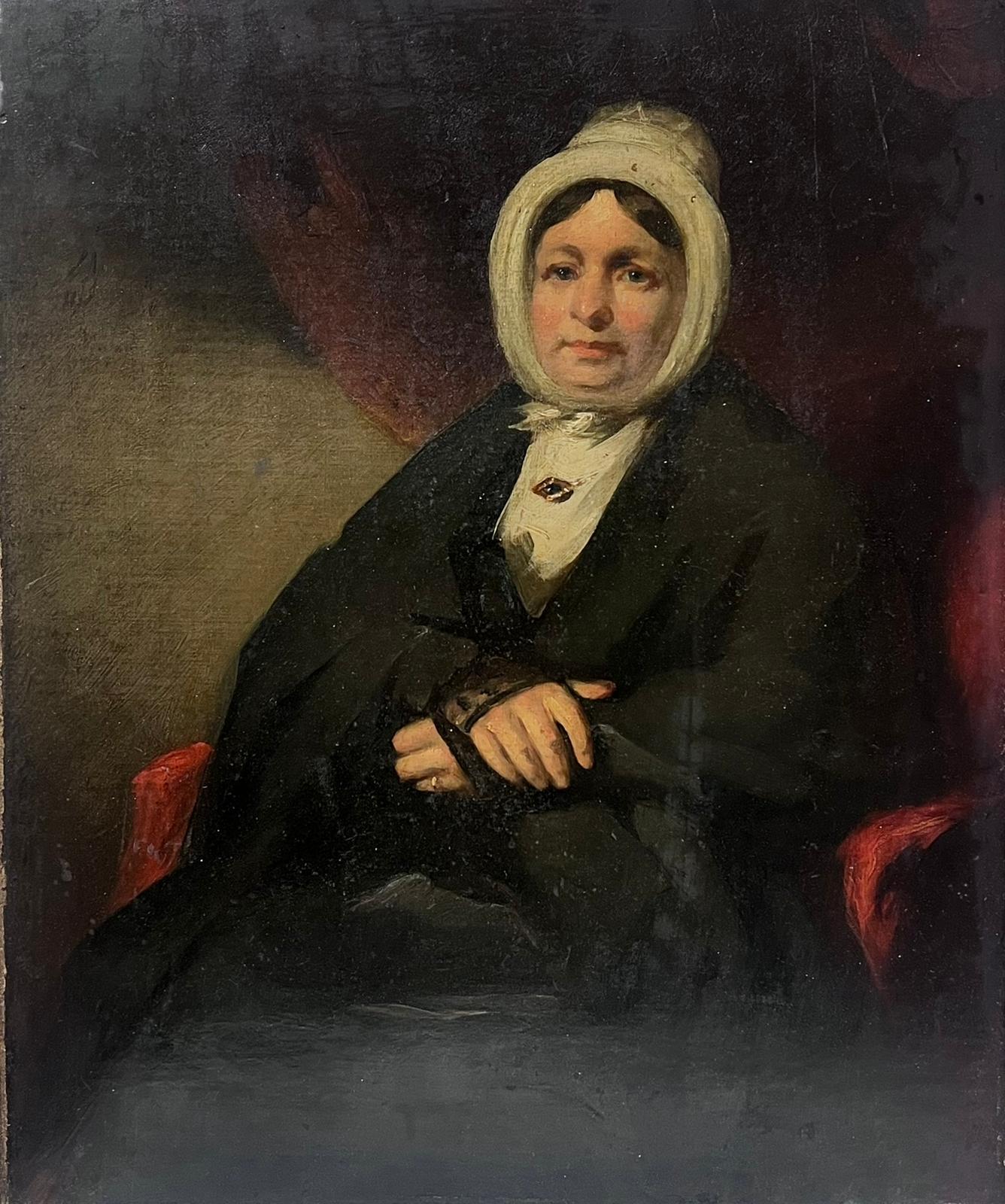Items Similar to Harvest Time - British Victorian exhibited art figurative landscape oil painting
Want more images or videos?
Request additional images or videos from the seller
1 of 19
Thomas Falcon MarshallHarvest Time - British Victorian exhibited art figurative landscape oil painting1849
1849
About the Item
This superb large exhibited British Victorian oil painting is by noted artist Thomas Falcon Marshall. Painted in 1849 it was exhibited at the Royal Academy London that year. This large painting depicts a father on his white horse saying goodbye to his family before heading off to the harvest, hence the exhibition title, 'the Orphans of the Village - Harvest Time'. There is also a partial quote from a poem by James Thomson. It is a beautiful landscape populated with several groups of people including the father and his family, workers having a drink behind him and labourers around the waggon in the field beyond. There is tremendous detail and beautiful colouring making this a thoroughly charming Victorian rustic genre scene and an excellent example of Marshall's work.
Signed lower left.
Provenance. Exhibited at the Royal Academy London, 1849 No. 612 entitled 'The Orphans of the Village - Harvest Time'. 'Be not too narrow, husbandman! but fling from the full sheaf, with charitable stealth, the liberal handful'. James Thomson
Condition. Oil on canvas, 50 inches by 40 inches and in good condition.
Frame. Housed in a complementary period gold leaf Victorian frame, 58 inches by 48 inches and in good condition.
Thomas Falcon Marshall (1818-1878) - was born in Liverpool in 1818 and was a prolific painter of rustic scenes, cottage interiors, farmyard scenes and historical scenes for which he had been greatly influenced by Oliver Goldsmith, Byron and others. His work also included portraits and watercolours. He was great admirer of William Frith. Marshall was an Associate, then member of the Liverpool Academy and was well represented in the Liverpool and Manchester exhibitions throughout his life. In 1840 he won a silver medal at the Society of Arts for an oil painting of a figure subject. In total he exhibited 60 works at the Royal Academy, 42 at the Suffolk Street Gallery in London and 40 at the British Institution. Although living in London for much of his life, he died in 1878 in Chorlton, Lancashire, survived by his wife Amelia Jane and his children, one of whom, William Elsob Marshall b.1843 was also an artist. His wealth at death was £2000. His work is displayed in museums in Liverpool and London and in galleries in Australia.
- Creator:Thomas Falcon Marshall (1818 - 1878)
- Creation Year:1849
- Dimensions:Height: 48 in (121.92 cm)Width: 58 in (147.32 cm)Depth: 2 in (5.08 cm)
- Medium:
- Movement & Style:
- Period:
- Condition:
- Gallery Location:London, GB
- Reference Number:1stDibs: LU853113244502
About the Seller
5.0
Platinum Seller
These expertly vetted sellers are 1stDibs' most experienced sellers and are rated highest by our customers.
1stDibs seller since 2018
400 sales on 1stDibs
Typical response time: <1 hour
- ShippingRetrieving quote...Ships From: London, United Kingdom
- Return PolicyA return for this item may be initiated within 14 days of delivery.
More From This SellerView All
- The Gossip - Scottish 19thC art Victorian oil painting young romantic coupleBy William Fettes DouglasLocated in London, GBA fine Victorian Scottish genre oil on canvas painting which dates to 1868 and is titled The Gossip by famous Scottish artist William Fettes Douglas RSA. It is a stunning depiction o...Category
19th Century Victorian Figurative Paintings
MaterialsOil
- Blessing the Harvest - Belgian 19thC art figurative Victorian oil paintingLocated in London, GBThis stunning arched top Victorian figurative oil painting is by noted Belgian artist Charles Soubre. It was painted in 1853 and is signed and date lower right. The composition is a ...Category
1850s Victorian Figurative Paintings
MaterialsOil
- Onward Christian Soldiers - British Edwardian 1911 art religious oil paintingBy Frank Owen SalisburyLocated in London, GBThis striking British Edwardian religious oil painting is by noted artist Francis 'Frank' Owen Salisbury or Frank O'Salisbury as he is largely known. Painted in 1911 it is a figurative landscape of soldiers on the battlefield. The two central characters, the 'Christian Soldiers' from the early crusades have halos and ride through the chaos on white horses. Shafts on light with angels illuminate them and also a crucifix. A very powerful Edwardian religious oil painting and an excellent example of O'Salisbury's work. painted in oil and illuminated in gold leaf. Signed and dated with monogram lower right 1911. Provenance. From Castle of Park, Aberdeenshire. A version of this painting was exhibited at the Royal Academy London in 1911 entitled the Passing of War. Condition. Oil on canvas, 36 inches by 24 inches unframed and in good condition. Frame. Housed a complementary frame, 44 inches by 32 inches framed and in good condition. Francis ("Frank") Owen Salisbury (18 December 1874 – 31 August 1962) was an English artist who specialised in portraits, large canvases of historical and ceremonial events, stained glass and book illustration. In his heyday he made a fortune on both sides of the Atlantic and was known as "Britain’s Painter Laureate". His art was steadfastly conservative and he was a vitriolic critic of Modern Art – particularly of his contemporaries Picasso, Chagall and Mondrian. His father, Henry Salisbury, described himself as a "plumber, decorator and ironmonger" (his mother was Susan Hawes), yet his son Frank would become one of the greatest society artists of his generation. One of 11 children, Salisbury was such a delicate child that he was educated at home, in the main by his student teacher sister, Emilie. He had only a few weeks formal schooling and began work by repairing bicycles at his father’s Cycle Depot in Harpenden. Uncertain as to his ability to find and maintain a job, the family determined that he be apprenticed, at the age of 15, to Henry James Salisbury, his eldest brother, who managed a major stained glass company in Alma Road, St Albans. He rapidly acquired all the practical skills of a stained glass artist and exhibited exceptional skills in the painterly detail that was applied to glass before its final firing. This led to his brother sponsoring him to attend Heatherley’s School of Art three days a week to further a career in painting. He then won a scholarship to the Royal Academy Schools which he attended for five years and where he won two silver medals and two scholarships, including the Landseer scholarship which funded his to travel to Italy in 1896. In due course he would have seventy exhibits accepted for the annual Royal Academy Summer Exhibitions, from 1899 until 1943, though he was never offered membership, which reportedly disappointed him very much. In 1901 he married Alice Maude (d. 1951), daughter of C. Colmer Greenwood, with whom he had several children, including twin daughters Monica and Sylvia. His first Royal Academy exhibit was a portrait of Alice and he often painted pictures of their children. It is for portraiture that he is best known. His speed in producing portraits stemmed from his painting his own twin daughters every morning for an hour and his career began with child portraiture and his painting the Hertfordshire gentry and members of the Harpenden Methodist Church. He had a studio at his home, Sarum Chase. A providential meeting with Lord Wakefield, founder of Castrol Oils and a Methodist philanthropist, saw his introduction to society portraiture. Salisbury’s being selected to paint the Boy Cornwell in the Battle of Jutland then brought him to the notice of Royalty. Lord Wakefield then arranged for him to paint President Woodrow Wilson whilst he was in London, but Wilson departed for Paris and the opportunity was lost. It was to be John W. Davis, American Ambassador to London, who encouraged Salisbury to go to the USA; Davis had met Salisbury at art receptions and had admired his child portraits. Twenty-five members of the Royal House of Windsor sat for Salisbury and he was the first artist to paint HM Queen Elizabeth II. In 1919 he painted a mural for the Royal Exchange, London National Peace Thanksgiving Service on the steps of St Paul’s Cathedral, 6th July 1919. He painted Winston Churchill on more occasions than any other artist; the two iconic images of Churchill – The Siren Suit and Blood, Sweat and Tears are both Salisbury images. Mayoral regalia was a ready made requisite for the Salisbury style with Councillor Sam Ryder (of Ryder Cup fame) as Mayor of St Albans being the most famous of his civic images. Other significant portraits include those of Richard Burton, Andrew Carnegie (posthumous), Sir Alan Cobham, Sir Robert Ludwig Mond, Maria Montessori...Category
1910s Realist Figurative Paintings
MaterialsOil
- Madonna and Child with St Catherine and Putti - Italian 17thC art oil paintingBy Giuseppe Bartolomeo ChiariLocated in London, GBThis stunning Italian 17th century Old Master religious oil painting is by Baroque artist Giuseppe Bartolomeo Chari. Painted circa 1684 it is a large and vibrant oil painting of the Madonna and child. To their left is Saint Catherine and to their right four putti or cherubs look upon a sleeping Jesus. The detail in all the figures faces and hair and the colouring is just superb, especially the Madonna's sumptuous blue robe. A really fabulous 17th century religious work with previous full attribution and excellent provenance which was once attributed to Carlo Maratta (1625-1713). Provenance. With Vangelisti, Lucca, Italy, 1966, from whom acquired by the family of the previous owner, and thence by descent. Red seal stamp verso Christies April 15th 1912 Christies March 23 1956 Condition. Oil on Canvas. Image size 44 x 54 inches unframed and in good condition. Frame. Housed in an original Carlo Maratta frame, 62 inches by 52 inches framed and in good condition. Giuseppe Bartolomeo Chiari (1654-1727), also known simply as Giuseppe Chiari, was an Italian painter of the late-Baroque period, active mostly in Rome. Born in Rome, he was one of the main assistants, along with Giuseppe Passeri and Andrea Procaccini, in the studio of an elder Carlo Maratta. His father had opposed the career, but his mother, on the recommendation of a painter named Carlo Antonio Gagliani. By the age of 22, he had frescoed the lateral lunettes (Birth of Virgin and Adoration of Magi...Category
17th Century Old Masters Portrait Paintings
MaterialsOil
- The Annunciation to the Shepherds - Dutch 17thC art religious oil paintingLocated in London, GBThis wonderful 17th century Old Master religious oil painting is attributed to Dutch Golden Age artist Benjamin Gerritsz Cuyp. Painted circa 1633 it is entitled The Annunciation to t...Category
17th Century Old Masters Portrait Paintings
MaterialsOil
- Portrait of a Young Welsh Girl - Enid Richards - British Edwardian Staithes artBy Ernest Higgins RiggLocated in London, GBA fine portrait oil on canvas by noted British Staithes listed artist Ernest Higgins Rigg. It is a super Edwardian portrait of Enid Richards and was painted at Govilon in Wales in 1...Category
1910s Realist Portrait Paintings
MaterialsOil
You May Also Like
- The Artist's StudioBy Irving E. HurlburtLocated in Storrs, CTThe Artist's Studio. c. 1914. Oil on canvas. 24 1/8 x 32. The canvas is in fine condition, having been professionally lined, cleaned and varnished. The painting is housed in a 29 1/2 x 37-inch Sully-style gold frame. Signed, lower right and also on the verso of the canvas in the center of the image. Hurlburt apparently created a 'period piece' work of art. The two maids are dressed in late 19th-century clothing. The slight puff at the top of the sleeve is 1897 - 1898. The maid on the left has her scarf done in a way that is quite Dutch or Flemish. The woman on the right has a headscarf that could just be the tie of the scarf making that shape in the front. If her hair is done up with a chignon in the back causing the scarf to be full in the back, the placement of that bun would make the piece 1908 - 1912. The "Psyche knot" was very popular in 1910. The woman in the painting on the easel is maybe old fashioned with a simpler and fuller version of early 20th century hairstyles. It's hard to tell if what is around her neck is a boa or a collar, but boas of all shapes and sizes were popular in the 1890's. Her gown is decidedly unfitted and appears to have a loose belt at the waist. If the skirt is in layers with the light skirt length over a darker skirt, that would put the outfit in 1910 or 1914. The problem is the waist. In 1910 - 1912 it was a neo-empire revival with a high waist. It wasn't until 1914 that the waists were coming back down with sashes at the waistline. It is just not specific enough to see the details that would help to date it. I guess I would be inclined to date it more 1914 - the approximate date of the woman in the painting, and assuming that the maids are dressed in an old fashioned way, but their skirts are awfully full and long for the period to be practical for cleaning. Irving E. Hurlburt lived and worked in New Haven, Connecticut. For most of his life, he resided at Wolcott Street in New Haven. Possibly the room is the artist's studio. He studied at the Yale School of Fine Arts, 1890-93 He was a member of the New Haven Paint and Clay Club. In 1888 he received the Ethel Childe Walker Prize at the Yale School of Fine Arts. His sketches of Pictures of New Haven show historic buildings, scenes and events of New Haven, CT. They were reproduced as wood engravings in the New Haven Almanack for the years 1906 to 1913, published by Ye Olde Hardware Store of the John E. Bassett Co. His other published sketches in that venue were: The Tontine Coffee House, Mayor Roger Sherman...Category
Early 20th Century Victorian Portrait Paintings
MaterialsOil
- Huge Victorian Oil Painting by Famous Artist Portrait Country Girl in HarvestBy Charles Sillem LidderdaleLocated in Cirencester, GloucestershireThe Gleaner by Charles Sillem LIDDERDALE (British, 1831-1895) signed & dated 1890 oil painting on canvas, framed in what we believe to be the original frame framed: 51.5 x 37.5 inch...Category
Late 19th Century Victorian Figurative Paintings
MaterialsOil, Canvas
- 19th Century French Portrait of a Nun in her Habit Large Oil on CanvasLocated in Cirencester, GloucestershirePortrait of a Nun French School, 19th century oil on canvas, simple wooden slip frame framed: 27.5 x 20 inches canvas: 27 x 19.75 inches provenance: private collection, Champagne reg...Category
Late 19th Century Victorian Portrait Paintings
MaterialsOil
- Antique French Oil Painting Portrait of a Country SquireLocated in Cirencester, GloucestershireFrench School, early 20th century oil on canvas, unframed canvas: 14 x 10.5 inches provenance: private collection, France condition: slightly scruffy with some scuffs and paint loss ...Category
Early 20th Century Victorian Portrait Paintings
MaterialsOil
- Antique French Portrait of a Country Lady in Large Dress & Hat oil on canvasLocated in Cirencester, GloucestershirePortrait of a Country Lady French School, early 20th century oil on canvas, unframed canvas: 14 x 10.5 inches provenance: private collection condition: good and sound condition thoug...Category
Early 20th Century Victorian Portrait Paintings
MaterialsOil
- Mid Victorian Portrait of a Lady Seated in a Chair Original 19th Century OilLocated in Cirencester, GloucestershirePortrait of a Seated Lady English School, mid 19th century oil on canvas, unframed canvas: 16 x 13 inches provenance: private collection, England condition: good and sound conditionCategory
Mid-19th Century Victorian Portrait Paintings
MaterialsOil, Canvas
